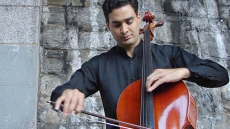"It’s a common belief that classical Indian dance is outdated and unappealing. I see it as my mission to show how beautiful Kathak is. I believe a contemporary approach to Kathak would reach more people."
Few people embody the concept of “Global Indian” like professional dancer Svetlana Tulasi. Born to a Telugu father and a Russian mother, Svetlana developed an interest for Kathak – one of the eight classical dances of India – early on.
Kathak is representative of the Northern and Western areas of the country and it is known for a heavy storytelling component. Through hand movements, facial expressions and considerable footwork, those who practice it share epic stories and local mythology just using their bodies.
Svetlana has helped popularize Kathak through her YouTube channel and appearances in Ukraine’s Got Talent (her performance went viral), Russia’s Got Talent and So You Think You Can Dance - Ukraine, among others. Svetlana has also been the lead in video clips (Zee Music Company’s “Hanju”, Indialucia’s “Trilokam”) and TV ads.
She practices at least an hour a day (four to five hours when on tour). In addition, she stays on top of new trends in contemporary dance while also revisiting more classical styles. “It’s important to stay inspired,” says Svetlana. A choreographer as well as a dancer, research often finds a way into her work: “Picasso said good artists copy, great artists steal. Learn how they do their thing and make it your own.” From this approach, Bollywood/hip-hop combinations have emerged, as well as multiple collaborations with Kumar Sharma.

While traditional ballet as known to Westerners is air-based, Kathak sticks close to the grown. Svetlana’s spin – Kathak fusion – allows her more freedom in lifting. “In the beginning, I was a purist. First comes the foundation, then you experiment. There is no growing without stepping back,” Svetlana believes. “If you choose an Indian art form, it’s important to know that you want to do this, no matter the obstacles.” Svetlana’s willingness to explore beyond her area of expertise translates into an eclectic taste in music, one that includes jazz, house, RnB, classical, alternative rock and the likes of Depeche Mode and Rammstein.
Following an extensive tour, Svetlana has changed gears slightly by making acting a bigger part of her artistic output. With that goal in mind, she spent five months in Los Angeles taking classes and auditioning. Her intention is to increase her presence this side of the Atlantic, although she says she’s “open to the whole world.” For now, expect Svetlana to pop up in video clips and continue her educational output online.

Q & A
What would you say is the biggest misconception about Kathak out there?
It’s a common belief that classical Indian dance is outdated and unappealing. I see it as my mission to show how beautiful Kathak is. Old is gold and classic lives forever. I believe a contemporary approach to Kathak would reach more people.
How has being Russian and Indian shaped your view of the world?
It has given me a great advantage, a global point of view. For example: My Kathak teacher (Yekaterina Seliviorstova) is Russian, but studied in India. As a result, her approach to teaching is structured and systemized, not how Kathak is usually taught in India. If awaken in the middle of the night, I would know the structure.
Indians around the world have made significant contributions to their immigrated countries. What do you think of this accomplishment?
Growing up outside India, there’s a missing part inside you. You feel disconnected of your roots. That’s how my interest in dance happened. If you have roots in India, you want to be a part of that. We all feel the need to be seen, to be heard, to represent Indian culture.




